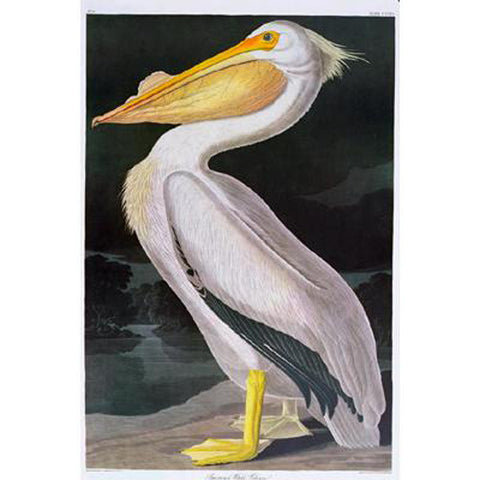Description
White Pelican, Pelecanus erythrorhynchos
Based on a composition painted perhaps in Florida in 1831 or 1832. Landscape artist, George Lehman, worked on the background.
The white pelican, with a wingspread of nine feet, does not plunge for food like the brown pelican, but fishes as it swims along, using the large bag that hangs from he lower part of its bill as a dip-net. It often gathers in groups for cooperative fishing. It nests for the most part far inland in the western half of the continent.
Audubon wrote: "Ranged along the margins of the sand-bar, in broken array, stand a hundred heavy-bodied Pelicans...Pluming themselves, the gorged Pelicans patiently wait the return of hunger. Should one chance to gape, all, as if by sympathy, in succession open their long and broad mandibles, yawning lazily and ludicrously...But mark, the red beams of the setting sun tinge the tall tops of the forest trees; the birds experience the cravings of hunger...they rise on their columnar legs, and heavily waddle to the water...And now the Pelicans...drive the little fishes toward the shallow shore, and then, with their enormous pouches spread like so many bag-nets, scoop them out and devour them in thousands."
EHJ
Print size: 26 1/4" x 39 1/4"; image size: 25 1/2 x 20"
Princeton Audubon Limited Edition - produced 1985
Princeton Audubon prints are direct-camera facsimile lithographs of the Robert Havell Jr. (1793-1878) engravings for The Birds of America (1827-38). Princeton's Double elephant Folio prints are issued in limited editions of 500 or 1500 prints. All are numbered and have a seal in the bottom margin to demonstrate their authenticity.
Printed on heavy Mohawk paper that is recommended by the Library of Congress for archives, the paper is specially toned to match the average paper color of the antique originals.
Item Number:
1732


